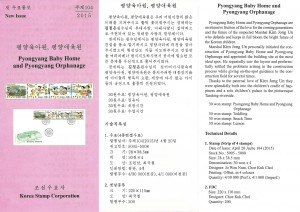UPDATE: Here is an older paper by Stacey Banks which I have not read: North Korean Telecommunication: On Hold.
ORIGINAL POST: On Monday the Orascom 3G mobile network launched in North Korea. Just about everyone covered this story…so here are the highlights:
Telecommunications in North Korea: Has Orascom Made the Connection?
Working Paper: Marcus Noland
The topicality of the second paper, on the Egyptian firm Orascom’s role in North Korea’s telecommunications modernization, received a boost this week with the announcement in Pyongyang that Orascom was finally rolling out its cell phone service and creating a joint venture bank with a North Korean partner. The planned Orascom investments are large: if actualized, they would be the largest non-Chinese or non-South Korean investments in North Korea, and would exceed total private investment in the Kaesong Industrial Complex to date
Financial Times
Orascom is confident North Korea is opening up its economy and says it has been assured by the government that everyone will be allowed to buy a mobile. However, experts think that such a volte-face is highly unlikely and reckon only senior military and government officials will be allowed access, and then only to a closed network.
When asked how many people would ultimately use the service, Orascom’s chairman Naguib Sawiris said: “We have a modest target of 5 to 10 per cent of the population.” The population is about 23m. Mr Sawiris expects 50,000 subscriptions in the first three-to-six months.
Jim Hoare, Britain’s former chargé d’affaires to Pyongyang, says the new network is bound to have severe restrictions.
“It’s unlikely that a country that doesn’t allow you to have a radio unless it’s set to the state frequency will suddenly allow everyone to have mobile phones. It’s more credible that there will be a limited network for officials in Pyongyang and Nampo.”
Dong Yong-sung, chief of the economic security team at the Samsung Economic Research Institute in Seoul, believes another obstacle to ordinary North Koreans owning phones will be the cost. “As far as I know, mobile phone registration costs about $1,000,” he said, a sum equivalent to the average annual income.
(NKeconWatch: Others put the price at $700…and there are many problems with asserting that the DPRK’s per capita income is $1,000 per year.)
Bloomberg
The inauguration of Koryolink took place today in North Korea, Orascom Telecom said in an e-mailed statement. Orascom Telecom Chief Executive Officer and Chairman Sawiris attended the event, a company official said, requesting anonymity. The Cairo- based company got a 25-year license and exclusive access for four years in January. It plans to spend as much as $400 million on a high-speed network and the license for the first three years.
The North Korean venture is “in line with our strategy to penetrate countries with high population and low penetration by providing the first mobile telephony services,” Sawiris said in a statement earlier this year.
CHEO Technology JV Company, the North Korean unit that will operate under the Koryolink name, is 75 percent owned by Orascom Telecom and 25 percent by the state-owned Korea Post and Telecommunications Corporation.
The unit will see average revenue per user of $12 to $15 this year as Orascom Telecom targets three of the country’s biggest cities, according to company forecasts.
Koryolink has rolled out its so-called third-generation grid to initially cover Pyongyang, with a population of 2 million.
Orascom is counting on four potential markets in the Stalinist nation, according to a study by Marcus Noland of the Peterson Institute for International Economics.
The military and government officials are the top targets, followed by foreigners working for UN organizations and diplomats. The others are customers from South Korea, which has several economic projects with its neighbor, and local demand from rich North Koreans.
To protect its investment, Orascom “hedged its bet, committing only half of its investment at the outset and making additional investment conditional on its assessment of conditions going forward,” Noland said.
If the deal is threatened, Orascom may withdraw specialized equipment or technicians, reducing the value of the network to Pyongyang, Noland said in his study.
“Orascom may have spread the wealth informally, creating beneficiaries within the decision-making apparatus who would stand to lose if the agreement failed,” according to the study.
Bloomberg
Orascom Telecom, the Middle East’s biggest wireless company, opened Ora Bank in Pyongyang in the presence of Chairman and Chief Executive Officer Naguib Sawiris, a company official said on condition of anonymity. Ezzeldine Heikal, who is also head of Koryolink, Orascom’s North Korean mobile-phone network, was appointed president of the bank, the official said without providing further details.
“This is a big deal, especially as far as North Korea is concerned, because the current banking system is virtually non- existent,” Marcus Noland of the Peterson Institute for International Economics said in a telephone interview from Washington, D.C. “It’s a ground that others have feared to tread and is perhaps an endorsement for North Korea that says ‘we’re open for business.’”
Ora Bank is a joint venture between Orascom Telecom and North Korea’s state-owned Foreign Trade Bank, North Korea’s official news agency reported today. The director of North Korea’s central bank Kim Chon Gyun and Egypt’s ambassador to Pyongyang Ismail Abdelrahman Ghoneim Hussein, were also present at the opening ceremony, the news agency said.
Radio Free Asia
Chinese traders who regularly travel back and forth to North Korea said local residents showed little enthusiasm for the new service, which cost more than U.S. $900 to set up before the Ryongchun explosion.
North Korean defector Kim Kwang-jin, a senior researcher at the Institute for National Security Strategy in Seoul, said the fact that the government had once pulled the plug on North Korean cell phones meant that it could easily do so again.
“In the beginning, people will be hesitant, because a few years ago many of them made a big investment in cell phones. But service was suspended abruptly, so they are still very concerned that might happen again,” Kim said.
“People are also worried that the ability to pay such a high amount of money for a cell phone may raise a red flag and bring them under scrutiny by the North Korean authorities.”
Most foreigners are banned from using cell phones while in North Korea, although a network for government officials is believed to exist in the capital, Pyongyang.
(NKeconWatch: I personally saw elite North Koreans use mobile phones and even some western journalists in 2005.)
The Guardan
North Korea first experimented with mobile phones in 2002, but recalled the handsets 18 months later after a mysterious train explosion that killed an estimated 160 people. Some experts argue that officials feared the incident was an attempt to assassinate the regime’s “dear leader”, Kim Jong-il, and that mobile phones were involved.
BBC
Some reports suggest that handsets for the new network will cost around $700 each, putting them far beyond the reach of the vast majority of people in the impoverished country.
Choson Ilbo
Although the technology would enable users to send and receive text messages and video content, North Korean customers will only be allowed to speak over their phones.
BMI Political Risk Analysis, Dec 16, 2008 (h/t Oliver)
BMI View: North Korea has officially begun third-generation (3G) mobile phone services, thanks to Egypt’s Orascom Telecom (OT). However, the growth of the network could be limited by the regime’s fear that mobile phones will increase the scope for anti-regime activities.
North Korea has officially commenced third-generation (3G) mobile phone services, thanks to an investment by Egypt’s Orascom Telecom (OT). The firm’s initial target is 100,000 subscribers in three major cities, including Pyongyang, and it eventually hopes to develop a nation-wide network connecting North Korea’s 23mn citizens. OT has promised to invest US$400mn in network infrastructure over the next four years. It has signed a 25-year contract with the North Korean government, and owns 75% of their joint-venture (known as Korealink). OT’s exclusivity rights will last for four years. Orascom’s foray is something of a coup, given that North Korea’s communications network is so rudimentary (for further background see December 8 2008, Industry Trend Analysis – North Korea Prepares For Mobile Network Launch).
Why Pyongyang Fears Mobile Phones
North Korea launched a mobile phone service operated by a Thai subsidiary firm in 2002, but reversed course in 2004, apparently because of a devastating bomb blast on a train in Ryongchon in April of that year. Given that North Korean leader Kim Jong Il’s personal train had passed through the area only a few hours earlier, there was speculation that the explosion had been an assassination attempt, possibly triggered by mobile phone. Since then, only those living in areas close to the border with China have had access to mobile phones, thanks to the proximity of the Chinese network.
Aside from the notion of mobile phones as bomb triggers, they can also make it easier for citizens to communicate with one another. This would increase citizens’ ability to organise anti-government activities – such as protests or sabotage. For example, the popular uprising that led to the overthrow of Philippine president Joseph Estrada in 2001 was dubbed the ‘text message revolution’, because that is how the marches were announced and coordinated. Admittedly, the Philippines is a far more open society than North Korea, but the subversive aspect has not been lost on the regime.
Mobile phones would also make it easier for North Koreans to communicate with the outside world, and thus allow the real-time transmission of information or intelligence to foreign media or spy agencies, and vice versa. They would also allow the North Korean elite to communicate more efficiently, allowing dissident elements to plot against the regime.
Thus, even something as basic as mobile phones are seen as potentially regime threatening.
Mobile Service Difficult To Spread
Consequently, Orascom will surely find it difficult to spread its mobile service across the country. For a start, registration will be tightly watched. Secondly, the cost of the handsets, at several hundred dollars, will mean that only the political and moneyed elites will be able to afford mobiles. Of course, elements of the elite can ‘misuse’ their phones to arrange subversive actions if they deem it worthy, but it seems that the regime are counting on loyalty. Indeed, depending on the sophistication of their equipment, the regime will probably be able to snoop in on the elite’s conversations and movements, giving them an additional layer of security.
Read the full articles below:
Orascom eyes North Korean network
Financial Times
Christian Oliver
12/14/2008
Orascom Telecom’s Sawiris Signs North Korean Deal
Bloomberg
Tarek Al-Issawi
12/15/2008
Orascom Telecom of Egypt Opens Bank in North Korea
Bloomberg
Tarek Al-Issawi
12/16/2008
North Korea Brings Back Cell Phones
Radio Free Asia
Jung Young
12/16/2008
Secretive North Korea launches restricted mobile phone service
The Guardian
Tania Branigan
12/16/2008
N Korea launches 3G phone network
BBC
Steve Jackson
12/15/2008
N.Korea Restarts Cell Phone Service
Choson Ilbo
12/17/2008


